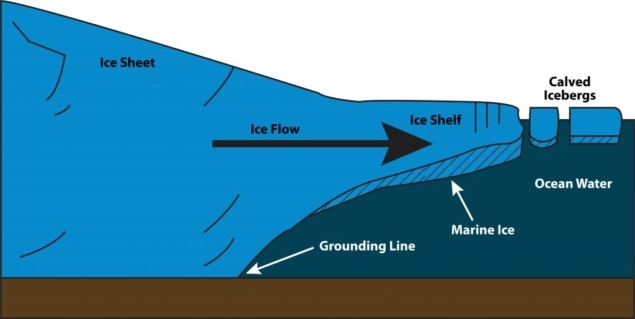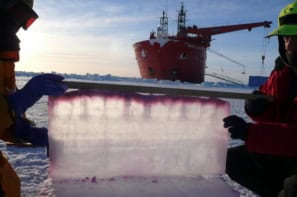Most icebergs look white or blue but since the early 1900s sailors have reported seeing dark green icebergs off some parts of Antarctica. And residents of Davis and Mawson stations, on opposite sides of Prydz Bay in East Antarctica, commonly see “jade bergs”. Now scientists may have identified the cause of the strange colouration – iron oxides from rock dust.
Icebergs result when large chunks of ice break off into the ocean from the ends of glaciers or ice shelves. As well as snow, and ice formed from compacted snow, icebergs calved from floating ice shelves may contain marine ice – ocean water frozen onto the bottom of the shelf in a layer that can be 100 m thick. It’s this marine ice that sometimes appears green; if it reaches the edge of the shelf without melting and breaks off as part of an iceberg that later tips over, it will be visible to passing sailors and researchers.

An early candidate for producing the green colour was dissolved organic carbon but later measurements showed similar levels of this carbon in both green and blue marine ice.
Rocky start
Stephen Warren of the University of Washington, US, and colleagues turned their thoughts to iron oxides following the discovery of large amounts of iron in East Antarctica’s Amery Ice Shelf.
Erosion turns iron-based rocks at the base of the ice sheet into “glacial flour”, the theory goes. Particles of this flour enter the water and nucleate ice crystals that float upwards, collecting more particles en route, to form a layer of green marine ice underneath the floating ice shelf.
But why is that ice green? If it doesn’t contain air bubbles, ice appears blue because it preferentially absorbs red wavelengths. Air bubbles, as found in the glacier ice formed from compacted snow, reduce this absorption by refracting light and scattering it out of the material. This clouds and whitens the ice’s appearance.

Marine ice, though, tends not to contain air as it forms under pressure several hundred metres beneath the ocean, where air is more soluble in water. In the absence of iron oxide, this marine ice appears clear and blue.
Add iron oxide particles to the mix and the marine ice’s natural blue combined with the red or yellow introduced by the mineral shifts the ice to absorb least light at green wavelengths. The result is an emerald green colour.
Warren began studying green icebergs in 1988, when he took a core from one example of the phenomenon near the Amery Ice Shelf.
“When we climbed up on that iceberg, the most amazing thing was actually not the colour but rather the clarity,” says Warren. “This ice had no bubbles. It was obvious that it was not ordinary glacier ice.”
Eat your greens
What’s more the iron in the icebergs may be playing a role in the wider ecosystem.

Rectangular iceberg calves Twitter spike
“We always thought green icebergs were just an exotic curiosity, but now we think they may actually be important,” says Warren. “The iceberg can deliver this iron out into the ocean far away, and then melt and deliver it to the phytoplankton that can use it as a nutrient. It’s like taking a package to the post office.”
Warren and colleagues from Bowdoin College, University at Albany, and State University of New York, all in the US, and the Australian Antarctic Division reported their work in Journal of Geophysical Research Oceans.



